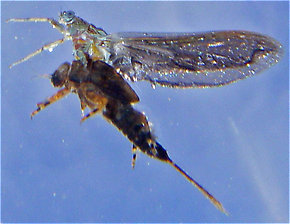Blog & Latest Updates
Fly Fishing Articles
Insects by Common Name


Mayfly Species Ephemerella dorothea infrequens (Pale Morning Dun)
Taxonomic Navigation -?-
Kingdom
Animalia (Animals)
» Phylum
Arthropoda (Arthropods)
» Class
Insecta (Insects)
» Order
Ephemeroptera (Mayflies)
» Species dorothea infrequens (Pale Morning Dun)
Common Name
| Match | Common Name |
| Pale Morning Dun |
This taxon used to be considered the separate species Ephemerella infrequens, but entomologists now regard it as a subspecies (Subspecies: Entomologists sometimes further divide a species into distinct groups called subspecies, which have two lower-case words on the end of their scientific name instead of one. The latter is the sub-species name. For example, Maccaffertium mexicanum mexicanum and Maccaffertium mexicanum integrum are two different subspecies of Maccaffertium mexicanum.) together with the small eastern Pale Evening Dun hatch Ephemerella dorothea dorothea. There is another related listing of significance common in California and the Southwest that has undergone revision. The large (often exceeding 10 mm) Ephemerella mollitia is now considered synonymous with d. infrequens.
While it is not the normal policy of TroutNut to list subspecies (Subspecies: Entomologists sometimes further divide a species into distinct groups called subspecies, which have two lower-case words on the end of their scientific name instead of one. The latter is the sub-species name. For example, Maccaffertium mexicanum mexicanum and Maccaffertium mexicanum integrum are two different subspecies of Maccaffertium mexicanum.) as separate taxa, d. infrequens and d. dorothea are so important and distinct from each other in terms of geography, appearence, and angling tradition that they warrant an exception.
Where & When
Region: West
Time Of Year (?): March-August, best in May-June in the coastal states;July-August in the Rockies
Preferred Waters: All types, but especially abundant in alkaline (Alkaline: Having a pH higher than 7 (opposite of acidic). Moderately alkaline water is ideal for trout because it's better for the growth of phytoplankton, the usual base of the aquatic food chain, and that's good for the growth of everything higher up the chain, including trout.) spring creeks.
Altitude: From near sea level on some West Coast tailwaters to as high as 8,000 ft.
This Western subspecies (Subspecies: Entomologists sometimes further divide a species into distinct groups called subspecies, which have two lower-case words on the end of their scientific name instead of one. The latter is the sub-species name. For example, Maccaffertium mexicanum mexicanum and Maccaffertium mexicanum integrum are two different subspecies of Maccaffertium mexicanum.) hatching cycle is more difficult to predict because of the high local variation in climate and the varieties of habitat including spring creeks, tailwaters and snow melt fed freestones. Hatches generally occur in the Rocky Mountain states from late Spring through the Summer months depending largely on elevation, latitude, and water type. They have been reported as early as March on some West Coast watersheds with mid-May to mid-June being the prime time at higher elevations. Despite the wide range of emergence dates, this hatch is usually prevalent on a given stretch of water for less than a few weeks or so, often mixing with the other Pale Morning Dun species Ephemerella excrucians as it begins to taper off. This often gives the impression of a much longer lived hatch. Because of this mix, some spring creeks and tailwaters in the West can have at least sparse activity of "PMD's" virtually the entire season. Caucci and Nastasi note in Hatches II that they can extend well into October on stable spring creeks. Fred Arbona writes in Mayflies, the Angler, and the Trout that they may appear during the last few weeks of June. Knopp and Cormier report their hatches during May in California.Time Of Year (?): March-August, best in May-June in the coastal states;July-August in the Rockies
Preferred Waters: All types, but especially abundant in alkaline (Alkaline: Having a pH higher than 7 (opposite of acidic). Moderately alkaline water is ideal for trout because it's better for the growth of phytoplankton, the usual base of the aquatic food chain, and that's good for the growth of everything higher up the chain, including trout.) spring creeks.
Altitude: From near sea level on some West Coast tailwaters to as high as 8,000 ft.
Hatching Behavior
Time Of Day (?): Usually midday often moving to evenings during warm weather
Habitat: Highly adaptable from freestone riffles to spring creek weedbeds
Water Temperature: variable depending on location
Classic surface emergers with long sedate floats in optimal weather. Have been reported to emerge subsurface in faster flows. They usually engage in "practice runs" exposing the nymphs to trout during extended pre-hatch periods.Habitat: Highly adaptable from freestone riffles to spring creek weedbeds
Water Temperature: variable depending on location
Spinner Behavior
Time Of Day: Usually morning and often again near dusk
Habitat: Riffles are preferred in freestone environments. Spring creek dwellers prefer specific locations determined by a variety of factors.
Hatched duns typically return to the stream within two days as spinners. After mating, both genders fall spent (Spent: The wing position of many aquatic insects when they fall on the water after mating. The wings of both sides lay flat on the water. The word may be used to describe insects with their wings in that position, as well as the position itself.) on the water.Habitat: Riffles are preferred in freestone environments. Spring creek dwellers prefer specific locations determined by a variety of factors.
Females often, but not always, drop their eggs from the air above the stream. When they do end up on the water with egg sacs still attached, trout may become selective to spinners with little bright yellow dots near the tail and upright wings as well. The gravid females are often active and far from "spent (Spent: The wing position of many aquatic insects when they fall on the water after mating. The wings of both sides lay flat on the water. The word may be used to describe insects with their wings in that position, as well as the position itself.)". Spent (Spent: The wing position of many aquatic insects when they fall on the water after mating. The wings of both sides lay flat on the water. The word may be used to describe insects with their wings in that position, as well as the position itself.) spinners usually cause the most feeding activity. Both male and female are usually similar enough that the same pattern can work for both, though the angler should take note of the differences in size between the sexes as the fish can become selective to one or the other. thogh often seen in the evening, mid- morning spinner falls have achieved legendary status at many locations.
Nymph Biology
Diet: Detritus (Detritus: Small, loose pieces of decaying organic matter underwater.), algae
Current Speed: Can be found in all current speeds, but especially near vegetation.
Substrate: Gravel, sand, vegetation
The nymphs display the usual Ephemerellidae habits of high activity in the hours and days before they hatch, and trout claim many of them before they're anywhere near the surface. They can be found in the benthic drift at almost any time of the day but concentrated behavioral drift (Behavioral drift: The nymphs and larvae of many aquatic insects sometimes release their grip on the bottom and drift downstream for a while with synchronized timing. This phenomenon increases their vulnerability to trout just like emergence, but it is invisible to the angler above the surface. In many species it occurs daily, most often just after dusk or just before dawn.) can occur in the evening. Color is not a good way to distinguish them from other Ephemerellids they often share habitat with. In addition to their larger size, another way to often tell them from their close relative excrucians is their lack of veriagation or striping of the abdominal dorsum (top). With a few less common exceptions, their lack of paired abdominal tubercles (Current Speed: Can be found in all current speeds, but especially near vegetation.
Substrate: Gravel, sand, vegetation
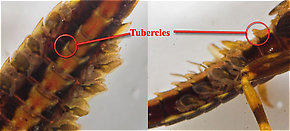
A few (not all) of the abdominal tubercles on this Ephemerella needhami nymph are circled. They are especially large in this species.
Pictures of 6 Mayfly Specimens in the Species Ephemerella dorothea infrequens:
Ephemerella dorothea infrequens (Pale Morning Dun) Mayfly Nymph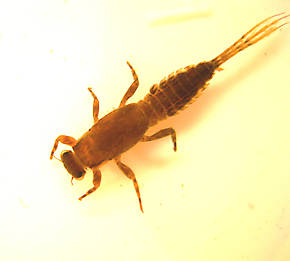 View 2 PicturesHabitat: Shallow riffle over cobble; approx. 1 ft. deep
View 2 PicturesHabitat: Shallow riffle over cobble; approx. 1 ft. deep
Size: 8.5 mm. Mature specimens have been captured as large as 10.5 mm.
Emergence schedule: Variable - starting as early as mid March and lasting as late as early June, depending on the year. Usual duration is at least several weeks or more.
Dun Association: Body is elusive pale creamy yellow w/ orange highlights, cream legs and tails, and dun wings
Specimen status in photo: Preserved
Collection method: Kick net
Comments: Extremely common in samples taken from this location. It's color in life was very close to as depicted in the photo; except for the gradual darkening of the abdominal segments as they progress posteriorly, which has been accentuated somewhat by the effects of preservation. Adult association is based upon capture of this taxon at various stages of emergence including: darkened wingcases, split thoraxic notums, and partially ecloded or ''stillborn (Stillborn: In fly fishing, a stillborn insect is one which got stuck in its nymphal or pupal shuck during emergence and floats helplessly on the surface instead of flying away. It is a specific class of cripple, although it is sometimes used interchangeably with that term.)'' specimens.
Entoman
 View 2 PicturesHabitat: Shallow riffle over cobble; approx. 1 ft. deep
View 2 PicturesHabitat: Shallow riffle over cobble; approx. 1 ft. deepSize: 8.5 mm. Mature specimens have been captured as large as 10.5 mm.
Emergence schedule: Variable - starting as early as mid March and lasting as late as early June, depending on the year. Usual duration is at least several weeks or more.
Dun Association: Body is elusive pale creamy yellow w/ orange highlights, cream legs and tails, and dun wings
Specimen status in photo: Preserved
Collection method: Kick net
Comments: Extremely common in samples taken from this location. It's color in life was very close to as depicted in the photo; except for the gradual darkening of the abdominal segments as they progress posteriorly, which has been accentuated somewhat by the effects of preservation. Adult association is based upon capture of this taxon at various stages of emergence including: darkened wingcases, split thoraxic notums, and partially ecloded or ''stillborn (Stillborn: In fly fishing, a stillborn insect is one which got stuck in its nymphal or pupal shuck during emergence and floats helplessly on the surface instead of flying away. It is a specific class of cripple, although it is sometimes used interchangeably with that term.)'' specimens.
Entoman
Collected March 21, 2011 from the Lower Yuba River in California
Added to Troutnut.com by Entoman on November 1, 2011
Added to Troutnut.com by Entoman on November 1, 2011
Male Ephemerella dorothea infrequens (Pale Morning Dun) Mayfly Spinner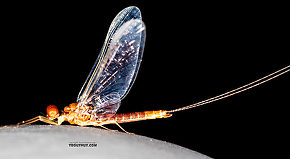 View 6 PicturesThis spinner was collected in proximity to this dun and this other dun, so one of them is likely the same species. Note for ID purposes that this one is missing one of its cerci (Cercus: The left and right "tails" of an insect are known as the cerci or caudal cerci. The middle tail of a three-tailed insect is not.).
View 6 PicturesThis spinner was collected in proximity to this dun and this other dun, so one of them is likely the same species. Note for ID purposes that this one is missing one of its cerci (Cercus: The left and right "tails" of an insect are known as the cerci or caudal cerci. The middle tail of a three-tailed insect is not.).
 View 6 PicturesThis spinner was collected in proximity to this dun and this other dun, so one of them is likely the same species. Note for ID purposes that this one is missing one of its cerci (Cercus: The left and right "tails" of an insect are known as the cerci or caudal cerci. The middle tail of a three-tailed insect is not.).
View 6 PicturesThis spinner was collected in proximity to this dun and this other dun, so one of them is likely the same species. Note for ID purposes that this one is missing one of its cerci (Cercus: The left and right "tails" of an insect are known as the cerci or caudal cerci. The middle tail of a three-tailed insect is not.).Collected July 1, 2019 from the Madison River in Montana
Added to Troutnut.com by Troutnut on July 18, 2019
Added to Troutnut.com by Troutnut on July 18, 2019
Male Ephemerella dorothea infrequens (Pale Morning Dun) Mayfly Spinner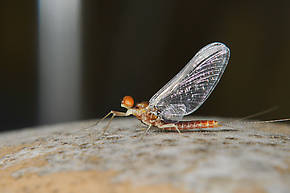 View 1 PicturesThis PMD spinner belongs to the subspecies (Subspecies: Entomologists sometimes further divide a species into distinct groups called subspecies, which have two lower-case words on the end of their scientific name instead of one. The latter is the sub-species name. For example, Maccaffertium mexicanum mexicanum and Maccaffertium mexicanum integrum are two different subspecies of Maccaffertium mexicanum.) Ephemerella dorothea infrequens.
View 1 PicturesThis PMD spinner belongs to the subspecies (Subspecies: Entomologists sometimes further divide a species into distinct groups called subspecies, which have two lower-case words on the end of their scientific name instead of one. The latter is the sub-species name. For example, Maccaffertium mexicanum mexicanum and Maccaffertium mexicanum integrum are two different subspecies of Maccaffertium mexicanum.) Ephemerella dorothea infrequens.
 View 1 PicturesThis PMD spinner belongs to the subspecies (Subspecies: Entomologists sometimes further divide a species into distinct groups called subspecies, which have two lower-case words on the end of their scientific name instead of one. The latter is the sub-species name. For example, Maccaffertium mexicanum mexicanum and Maccaffertium mexicanum integrum are two different subspecies of Maccaffertium mexicanum.) Ephemerella dorothea infrequens.
View 1 PicturesThis PMD spinner belongs to the subspecies (Subspecies: Entomologists sometimes further divide a species into distinct groups called subspecies, which have two lower-case words on the end of their scientific name instead of one. The latter is the sub-species name. For example, Maccaffertium mexicanum mexicanum and Maccaffertium mexicanum integrum are two different subspecies of Maccaffertium mexicanum.) Ephemerella dorothea infrequens.Collected June 15, 2011 from the Touchet River in Washington
Added to Troutnut.com by Bnewell on June 24, 2011
Added to Troutnut.com by Bnewell on June 24, 2011
Recent Discussions of Ephemerella dorothea infrequens
So is Ep Infrequens now known as Ep Dorothea? 20 Replies »
Posted by Wbranch on Feb 17, 2008
Last reply on Jul 1, 2014 by Crepuscular
These mayflies look more like the Sulfurs I see on the Delaware system than the PMD's I see in Montana. The Montana mayfly has a distinct yellow leading edge to an overall light dun gray wing and the abdomen and thorax have a more light greenish/yellow cloration so how is it that Infrequens is now known as Ep Dorothea Dorothea?
ReplyYour Thoughts On Ephemerella dorothea infrequens:
Top 10 Fly Hatches
Top Gift Shop Designs
Eat mayflies.
Top Insect Specimens
Miscellaneous Sites
Troutnut.com is copyright © 2004-2024 Jason
Neuswanger (email Jason). See my FAQ for information about use of my images.
 privacy policy
privacy policy

